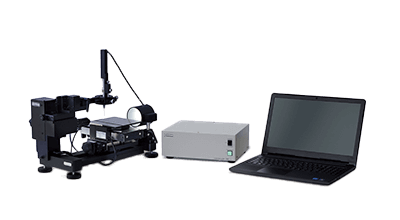What Is Contact Angle Meter?

Contact Angle Meter is a device that evaluates the contact angle of a drop of liquid on a solid surface.
In wettability evaluation, contact angle is the angle between a solid surface and a droplet, and is used as a numerical value to express the wettability of a material. Wettability is a numerical expression of the compatibility of contact between a solid surface and a liquid.
In our daily lives, for example, the surface of a waterproof raincoat or umbrella repels water well. Conversely, in the painting process, it is essential for the paint to spread without being repelled by the painted surface in order to perform the painting process efficiently.
In addition, some products are designed to make it easier to remove dirt from exterior walls of buildings by making the paint surface easy for rainwater to run off after it dries.
Applications of Contact Angle Meter
Contact Angle Meter is used to measure the water repellency, water resistance, and conversely, hydrophilic performance of various industrial products. When a liquid is bounced off a solid surface, it is called low wettability, and when a liquid spreads easily on a solid surface, it is called high wettability.
When wettability is low, the contact angle is large, and when wettability is low, the contact angle is small.
1. Contact Angle Cleaning Evaluation
In cases where cleanliness has a significant impact on product characteristics and quality, contact angle can be used to evaluate cleanliness in a relatively easy and inexpensive manner. Specifically, it is used in the manufacture of silicon wafers, semiconductors, glass substrates, electronic components, liquid crystal glass, etc.
2. Contact Angle Wettability Evaluation
In painting, adhesion between the paint and the material to be painted is important. Contact angle is used to evaluate the adhesion of the paint. Inks, paints, and application processes are subject to evaluation.
It is also used in building exterior paints as an indicator to evaluate the stain resistance of buildings, and when wettability is good, stains are washed away with rain.
3. Contact Angle Hydrophobicity Evaluation
For products that require water resistance, the contact angle is used to evaluate how well the product can repel water. Examples include water repellents, waxes, waterproof coatings, and rainwear.
4. Contact Angle Adhesion Evaluation
In sealing materials for bonding and filling gaps, we evaluate their compatibility with the base material. It is performed as an evaluation of sealing, adhesion, sealability, and application process.
5. Contact Angle Cleanliness Contamination Evaluation
Contact angle is measured to evaluate cleanliness in clean rooms.
6. Contact Angle Surface Modification Evaluation
Contact angle is used to evaluate the process of surface modification by UVO3, plasma, corona discharge, etc.
Principle of Contact Angle Meter
Contact Angle Meter actually drops a liquid on the surface of the target substrate, takes a picture of the drop with a camera from the side, and determines the contact angle from the shape of the drop. This is a relatively primitive method where the definition of contact angle is directly tested and judged from the image.
If the wettability of the sample to be evaluated is high, the droplet on the substrate will be collapsed and spread out, resulting in a small contact angle. On the other hand, if the wettability is low, the droplets on the substrate maintain a spherical shape and the contact angle increases.
Wettability is related to the surface tension of the liquid, the surface tension of the solid, and the interfacial tension between the liquid and the solid.
γs = γlcosθ + γsl
γs: surface tension of solid, γl: surface tension of liquid, γsl: interfacial tension between solid and liquid, θ: contact angle
Structure of Contact Angle Meter
Contact Angle Meter consists of a dispenser for creating droplets, a light source and CCD camera for observing the interface, and a sample stage for installing a substrate. In addition, to measure the dynamic contact angle described below, a sliding unit is attached to tilt the entire device and the specimen stage.
Other Information on Contact Angle Meter
1. Types of Contact Angles
There are two types of contact angles: static contact angle and dynamic contact angle. When a droplet is dropped on a water-repellent material, the shape of the droplet, such as height and contact radius, changes slowly and is not stable. The contact angle after one to several seconds after the droplet is deposited is generally considered to be the “static contact angle.
After a droplet is deposited on the surface of the material to be evaluated, the droplet begins to slide on the surface as the material is tilted. The angle at the moment the droplet begins to slide is called the slip or tumble angle. The contact angle in the direction the droplet falls is called the forward contact angle and the opposite is called the backward contact angle, both of which are called the dynamic contact angle.
2. Contact Angle Measurement Method
Contact Angle Meter reads the contact angle from the shape of the liquid actually dropped on the sample surface, and there are several measurement methods.
Droplet method
The droplet method is the basic method for evaluating the static contact angle. A drop of liquid is dispensed onto the test surface, and an image of the droplet shape is acquired from right beside the surface to calculate the contact angle of the droplet.
Extension-Contraction Method
In the expansion and contraction method, an image is captured while the liquid is repeatedly dispensed and aspirated. The forward and backward contact angles are obtained as dynamic contact angles.
Slip-and-Fall Method
In the slip-and-fall method, liquid is first dropped onto a horizontal solid sample surface, and then the sample stage is tilted to obtain the slip-and-fall angle and the dynamic contact angle.